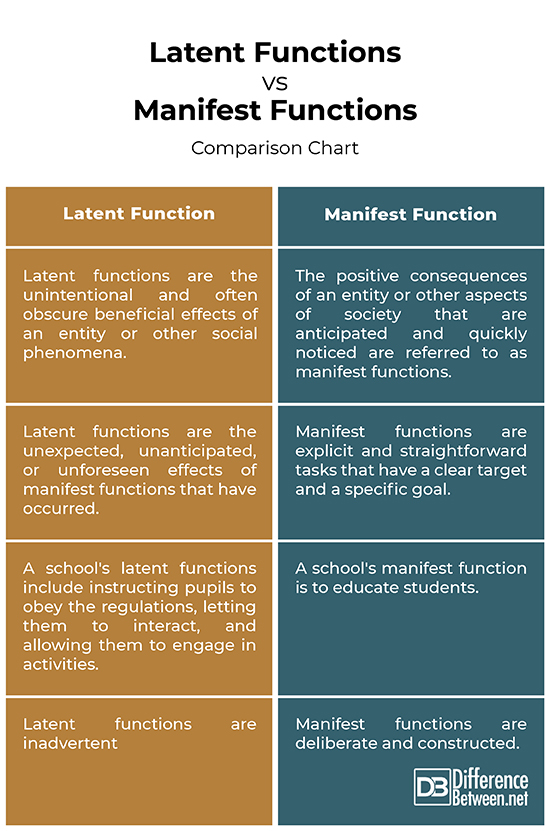Difference Between Manifest Function and Latent Functions

Robert Merton (1949) proposed the difference between manifest and latent functions to differentiate between “conscious motivations for social behaviors, and its objective consequences” or, visible factual repercussions of intuitive inclinations, as he puts it somewhere else (pp.24,63).
According to Merton, the term “manifest function” describes the deliberate purpose of social policies, procedures, or activities that are purposefully and deliberately meant to have a favorable influence on society. He further posited that manifest function is visible and are the intentional purposes of institutions in society.
In contrast, a latent function is one that is not intentionally performed but yet benefits society.

Difference between latent and manifest functions
Latent functions are often unplanned or unnoticed by any social hierarchy. They are noticeable but not readily seen, whilst manifest functions refer to the purposeful or intentional functions of social policies or actions that are developed for the betterment of society. When actors perform manifest functions, they are cognisant of their actions, whereas when actors perform latent functions, they are unaware of their conduct.
For example, if a regulation is established, the manifest function will be the purpose for which the rule was created but in contrast, the latent function is the unexpected function; for example, if a rule is enacted to ensure peace but results in societal harm, that harm is the latent function.
In nature, manifest functions are helpful, whereas latent functions can both hurt and help society. As a result, latent functions have a proclivity to become dysfunctional. This, however, is not always the case. Dysfunctions are latent functions that hurt society by causing social disorder and conflict. Unless they are dysfunctions or functions that result in undesirable results, latent functions frequently go undiscovered. It is not unusual for manifest functions to be dysfunctional at times; in many cases, it is already recognized that a policy or action would have a detrimental impact. Nonetheless, because they are unidentified and unanticipated, latent dysfunctions are of more concern because they cause more irreversible harm to society.
Latent functions vs. Manifest functions: Comparison Chart

Summary
In summary, there are two sorts of social functions: latent and manifest functions. Latent functions are the unintentional and sometimes unnoticed favorable repercussions of an entity or other social phenomenon. However, manifest functions are the intentional and anticipated good outcomes. This is the primary distinction separating latent and manifest functions.
FAQ questions:
What is the difference between manifest and latent functions give example?
Manifest functions are intentional and well-understood. While many latent functions are unintentional and/or go unnoticed. For instance, clinics are supposed to give quality treatment to individuals or to help patients suffering from various illnesses or who have been involved in an accident, among other things.
Conversely, an example of latent function could be that in a hospital, whilst providing treatment to a person sick from a certain type of debilitating illness, the physicians eventually save the patient, thus learning a new means of treating that specific condition.
What is the difference between latent and manifest functions of education?
Latent functions in a learning facility include the formation of peer relationships among students enrolled in the same college or school; their ability to socialize through school functions such as sporting activities, and so on.
Latent functions in education setting include educating pupils to observe the rules, allowing them to socialize and participate in activities. It is to educate the students.
What is the difference between manifest and latent functions in sociology?
The distinction between the latent function and the manifest function is why sociologists seek to go beyond the justifications that individuals, institutions, and other entities generally give for their activities. They are more likely to look for the social ramifications of society’s varied behaviors. The desired purpose of social systems, procedures, or behaviors that are intentionally and purposefully meant to be useful to society is referred to as manifest function in sociology. Alternatively, a latent function is something not intentionally designed but does have a positive impact on society
Sociologists realize that social structures create latent functions in addition to manifest functions that extend beyond the individuals’ common-sense perceptions and examine the latent repercussions of social structures.
For instance, if a felon is penalized, everybody understands that this is general societal way of indicating that deviant behavior is not tolerated. This is known as manifest function. The latent function of this censure, on the other hand, maintains society’s confidence in its moral standards.
- Difference Between Theory of Action and Theory of Change - February 23, 2022
- Difference Between Manifest Function and Latent Functions - February 23, 2022
- Difference Between Autocracy and Dictatorship - February 18, 2022
Search DifferenceBetween.net :
Leave a Response
References :
[0]Merton, Robert K. Social theory and social structure. No. HM51 M3. 1949.
[1]Merton, Robert King, and Robert C. Merton. Social theory and social structure. Simon and Schuster, 1968.
